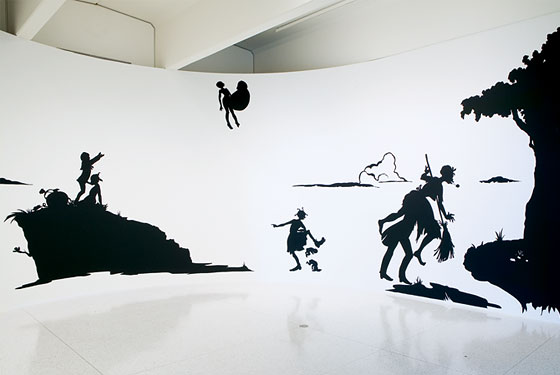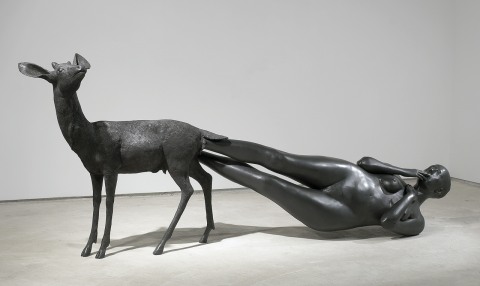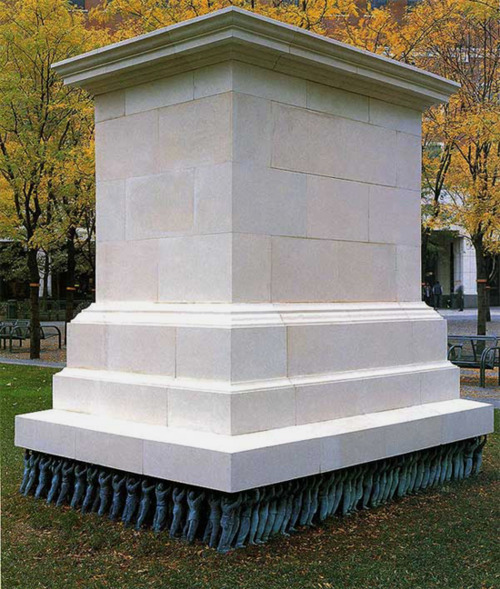Kara Walker:
The first artist mentioned in this episode is Kara Walker, an African-American woman who was born in California but moved to Stone Mountain, Georgia, where she spent most of her child years at. Stone Mountain was a haven for the KKK, and the center of both the mythology and reality of viciousness in the South targeted mainly at the Black children. Walker struggled with the move to Georgia, and became extremely interested in the history of slavery and the relationships with Black and White people in the South throughout slavery.
 |
| http://cdn.newsone.com/files/2009/10/kara-walker-721276.jpg |
Walker displays this interest in her art, which is unlike any other. Walker uses huge cut-outs of both black and white paper on very simple backgrounds, in order to portray the "White in Black America", or the "Black in White America". Walker uses huge life-size cutouts, round rooms completely surrounding the viewers, and overhead projectors in order to make the viewer feel as if they are part of the scene. When the viewer is standing in front of the art, their shadow is projected into the scene, making them a part of the story. Walker attempts to show the concept of power in her art, as well as the different ploys to steal power away from those who have it.
 |
| http://images.nymag.com/arts/art/reviews/walker071112_560.jpg |
Her work has been shown in various museums around the world, included but not limited to Sao Paolo, Brazil and New York City.
Kiki Smith:
Oftentimes when visiting a museum, you will look at a piece of art or an entire exhibit even and wonder what on earth you are looking at, but after reading and learning more about the artist, you will understand it's meaning. Kiki Smith's art is exactly that type of art. Growing up in a house surrounded with "death everywhere," Kiki Smith became completely enamored in death. Her father kept his dead parents clothing and dentures in the house, there were tombstones with everyone's names on them in front of the house, and "death masks" made of every family member's faces and hands who passed away (three generations of them).
 |
| http://bloggy.com/mt/archives/kiki-smith.jpg |
Smith portrayed this obsession and infatuation with death in her art, when she spent years and years drawing dead animals. She even believed that it was her duty to make an entire remake of Noah's Ark, but instead of having the animals alive, they would be dead.
 |
| http://www.firstpulseprojects.net/Out-of-the-Blue/ksmith-birds-inside-x.jpg |
Eventually, Smith switched from dead animals to creating sculptures of women, oftentimes witch like figures, mixed in with animals. She drew much of her inspiration from her previous work, for she wanted her characters not only to exist in one sculpture or drawing but to have a life outside of just one version. Art to Smith has a specific meaning, and she hopes it creates a different meaning to all of her viewers.
 |
| http://selections.rockefeller.edu/cms/images/stories/illustrations/daisy_chain.png |
 |
| http://media.walkerart.org/4076480.jpg |
Unlike the other artists, Do-Hu Suh was born outside of the United States in Seoul, Korea. He left home for his father was a successful painter, and he felt that no matter what he did, he would always be overshadowed by his father. After leaving Korea and moving to New York City, Suh realized that he was completely homesick and wanted to create art that would remind him of home.
First, Suh wanted to create a "transportable home", similar to that used of a snail, for it could be placed in different places and moved wherever it was necessary. Suh found people who used traditional techniques of sewing fabrics to show him how to do it, and he made various different copies of his home in Korea out of fabric, that could be folded up into a suitcase and brought with him wherever he wanted to go.
Suh continued to make art that reminded him of Korea, and specifically Seoul. Suh was intersted in the cultural displacement, and the differences between his culture and the culture in America. Seoul was a very busy place and people had little personal space, unlike in America. Suh really toggles with the idea of the individual versus the collective when creating his art. Korea is an extremely militaristic and hierarchical society, he claims, in which no one is allowed to be an individual. Because of this, Suh creates art in which he superimposes his face with the face of his 60 classmates and calls it a self-portrati. In addition, Suh collected yearbooks all throughout the 1900's and put every portrait together on a huge piece, in which he claims he saw various faces over and over and over again, therefore discrediting the idea that humans are all unique.
In addition, Suh was asked to make a public monument, in which he struggled with what to put. Ultimately, Suh decided that instead of making it a huge monument celebrating a famous individual, he would make a smaller monument with many people, in which everyday citizens would feel recognized and honored.
 |
| http://1postozaumjetnost.files.wordpress.com/2010/10/do-ho-suh-public-figuresnew-york-1998-1999.jpg |
Trenton Doyle Hancock:
Growing up in the Sotuh in a very religious family filed with music, community and mythological stories, Trenton Doyle Hancock wanted to become a comic book artist when he was younger and tell stories through using made-up characters and super heros. Eventually, Hancock's interest in art changed, but he still wanted to use super hero like characters to tell stories in a panel-by-panel narrative.
Hancock created different characters and alter-egos that he uses in his work, for example Loid, a character that is portrayed through his use of black and white and words, Painter, a character the represents color and joy and happiness, and Torpedo Boy, the alter-ego of himself. Hancock tells a story in each of his works, in which a Mound, a half-human and half-plant character interacts with Loid, Painter and Torpedo Boy. In each piece of artwork, Hancock messes around with abstract colors and words, but still blends in different aspects of his vision.
Hancock mixes natures and humans in most of his artwork, and uses the idea of Noah's Ark very strongly, for he loves to beauty that the animals could all put apart their differences in order to come to one. Hancock describes his art as "colorful blasts of energy," and also as "visions of hope." He feels that he mixes comic book narratives and story telling with abstract art, and the history of the abstract.
 |
| http://artandseek.net/files/2010/09/hancock.jpg |
Hancock created different characters and alter-egos that he uses in his work, for example Loid, a character that is portrayed through his use of black and white and words, Painter, a character the represents color and joy and happiness, and Torpedo Boy, the alter-ego of himself. Hancock tells a story in each of his works, in which a Mound, a half-human and half-plant character interacts with Loid, Painter and Torpedo Boy. In each piece of artwork, Hancock messes around with abstract colors and words, but still blends in different aspects of his vision.
 |
| http://cdn2.lostateminor.com/wp-content/uploads/2009/04/trenton-doyle-hancock-2.jpg |
 |
| http://1.bp.blogspot.com/_yb5SlOB2wIo/So3kabaIrCI/AAAAAAAAABI/SkNZ3CHUjyY /s320/trenton%2Bdoyle%2Bhancock4.jpg |
Hancock mixes natures and humans in most of his artwork, and uses the idea of Noah's Ark very strongly, for he loves to beauty that the animals could all put apart their differences in order to come to one. Hancock describes his art as "colorful blasts of energy," and also as "visions of hope." He feels that he mixes comic book narratives and story telling with abstract art, and the history of the abstract.
 |
| http://whitney.org/image_columns/0026/9387/2001.229_hancocktd_detail_640.jpg |
 |
| http://frontrow.dmagazine.com/wp-content/uploads/2010/03/Trent-Doyle-Hancok.jpg |



No comments:
Post a Comment